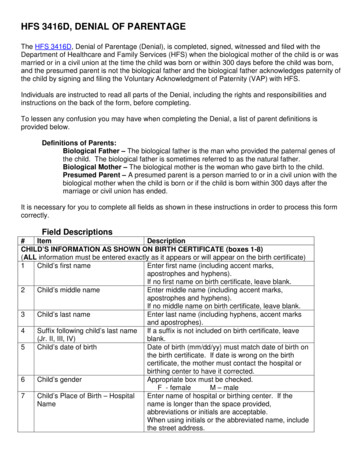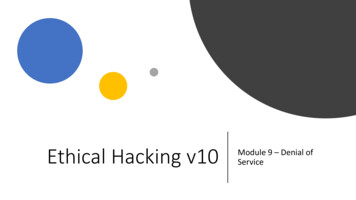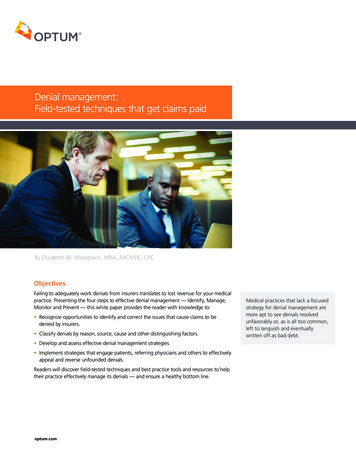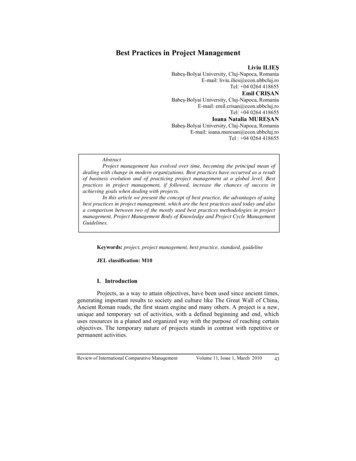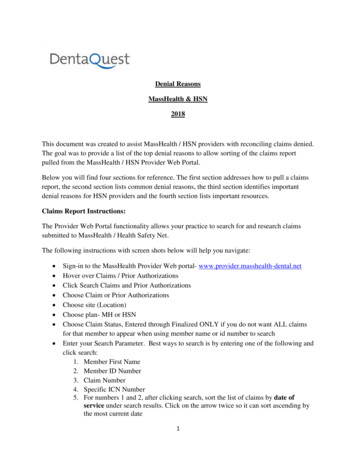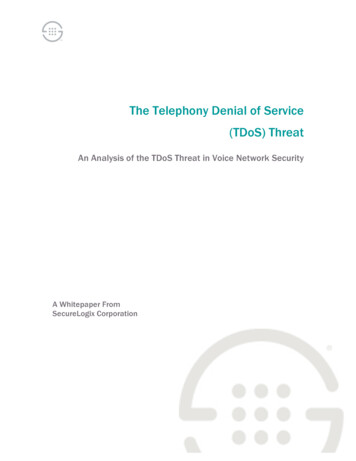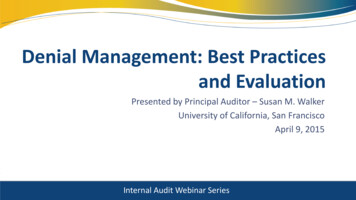
Transcription
Denial Management: Best Practicesand EvaluationPresented by Principal Auditor – Susan M. WalkerUniversity of California, San FranciscoApril 9, 2015Internal Audit Webinar Series
Webinar Agenda Project OverviewBackgroundAudit ObjectivesRisk AssessmentAudit ProceduresLeading Practices in Place at UCSFObservationsLessons LearnedConclusionQ&AResources
Project Overview Title and timing: Denial Management, August 2014 Project type: Revenue Cycle Audit Purpose: Assess the effectiveness and efficiency of the denialmanagement process Scope: Inpatient denials from October 2013 through April 2014 Resources: Staffing: Principal Auditor Budget: 185 hours total
Importance of Denial Management Cost: Write-offs are around 3% of net revenue Increased risk: Gross charges denied as a percentage of billing value is growing Increased complexity in billing requirements Benefit: Most denials are appealable But prevention is better
Executive SummaryOverall: Patient Financial Services (PFS) has put in place avariety of processes, procedures, and technical tools toidentify and manage denied claims and PFS is generallyfollowing industry practices for denial management.Risks identified for thisarea include lack ofprocesses to trackdenials, identify rootcauses, and deploydenial preventionstrategies. Additionally,communication betweendenial processers andclinical departments canbe a barrier to successfuldenials management.
Background Denial Process Occur when payor perceives errors in a claim Technical, process, medical necessity Payor notifies claim submitter of non-payment, along with reason Authorization Coding Documentation Eligibility Late Filing Routing Denial is reviewed and action taken Appeal, resubmit with additional information, transfer, write-off
Background (cont’d)Patient Financial Services (PFS) Organizational Setting: Patient Financial Services (PFS) has responsibility forbilling, managing, and collecting Medical Centerrevenue for inpatient and outpatient services providedthroughout the UCSF provider network Denials are processed by follow-up staff who also areresponsible for billing submissions, collections,requests for information, and write-offs. They are splitinto two sections: one section deals with governmentpayors, the other with commercial f
Background (cont’d) Prior work done: Audit Services (2009) Similar review on previous system Huron (2012) Denials Management structureUse of APeX Multi-Care (2013) Entire revenue cycle processEnhanced reporting
Audit Objectives Assess the adequacy of the internal controls in place for effective andefficient management of denials Determine the effectiveness of the processes for denials prevention Evaluate the processes for denial resolution for effectiveness
Risk Assessment Risk assessment sources: Prior reviews Industry white papers Consultant reports Main areas of risk: New processes Turnover in PFS Insufficient information gathered at time of service Insufficient information from payor Barriers to communication
Audit Procedures Interviewed staff involved in denial management in orderto determine whether denials were being defined andtracked Assessed the denial process to determine if managementwas following industry practices, and whether there werepotential improvements that could be implemented Reviewed the Billing Department Code, Reason CodeTrends, and Average Write Off reports containinginformation on denials and write-offs to assess theoversight and monitoring of denialsAreas excluded: Case managementprocesses Actions taken bydepartmentmanagement Patient Accessprocesses Outsourced denials
Audit Procedures (cont’d) Conducted further analysis by trending and analyzing the data contained in thesereports in order to conclude on the effectiveness of the denial management process Determined if root cause analysis was being conducted on denials and if this analysiswas being documented in the issues log Analyzed the issues log and reviewed trends in denials that had been identified inorder to determine actions being taken were effective in reducing future similardenials Analyzed write-offs due to untimely appeal and follow-up to determine if the denialresolution process was working efficiently
Leading Practices in Place at UCSF Integrating multiple groups into the revenue and denial managementfunctions to enable better identification of trends and assignment ofresolution Subcommittees included representatives from ADT/Registration, CaseManagement, HIMS, PFS, and Billing Office Clearly defining roles, responsibilities and organizational structure for denialmanagement for enhanced accountability PFS provides timely information to designated representatives for functionalareas Bi-monthly meetings held by Denials Task Force Responsibilities assigned for trend and root cause analysis
Leading Practices in Place (cont’d) Monitoring, measuring and reporting of denials for improved identification oftrends Denial Reason Code (DRC) report Billing Department Code (BDC) report Tracking and trending rejections to identify on-going issues Issues Log Monitoring write-offs and maintaining appropriate authorization levels forwrite-offs to improve revenue collection Avoidable Write-Off (AWO) report Approval authority in APeX
Leading Practices in Place (cont’d) Communication to appropriate clinical and front-end departments to facilitatemore timely resolution of denials Use of referral processes in APeX Implementing appeals process across departments for improved timelinessand effectiveness Integrating technology between clinical and revenue cycle process areas forenhanced communication Use of APeX capabilities and analysis results
Leading Practices in Place (cont’d) Integrating denial recovery activities to improve efficiency and effectiveness ofdenial resolution Classification for appropriate assignment and actions Workflow enhancements Providing feedback on denials to appropriate back-end departments (Finance,Information System) for improved information and data reporting Enhanced classification structure and timely data Additional review for accuracy
Leading Practices in Place (cont’d) Improving communication/negotiation with payer to reduce non-preventabledenials Identification of issues Communication with contracting
Observations Classifying all denials to ensure that complete data on preventability andowning areas for denials are captured Not a hard stop, may not have complete information Providing feedback to the follow-up staff responsible for selecting owningareas, root causes, and preventability for denials when poor or missingselections are identified Secondary review improves accuracy, but tracking of individual accuracy not done Setting performance goals and targets for denial management Tracking done for issue identification, not performance
Summary - Lessons Learned What went well Clear benefit to review Structure allowed for concurrent improvements What obstacles occurred New process Staff in flux How can denials information be used Future revenue cycle reviews
Conclusion Key takeaways for denial management Increased capture and analysis of data Different data points and trends Denied Days per Admission Denials by Service Area Consistent communication AdaptabilityTemplate created 11-19-14 by UC Santa Cruz
Q&A
Additional Resources HFMA hfm magazine February 2015 - Reducing Lost Revenue from Inpatient Medical-Necessity Denials Webinars November 2013 – Denials Management: Throwing ICD-10 in the Mix AHIA New Perspectives June 2010 - Aim High: High-Value Revenue Cycle Audits Protect and Improve the BottomLineJune 2009 - Focusing on Preventing Denials: How to Assist
Audit ProgramAudit ObjectivesTest StepsAssess the adequacy of the internal controls in place foreffective and efficient management of denials1. Review denials policies and processes for clarity andthoroughness.2. Validate that denials are defined and tracked.3. Review oversight and monitoring of denials processingsuch as the analyses done on denials for best practicesof data reviewed.4. Trace a sample of denials through the process tovalidate that the owning area for the denial is assignedappropriately, a root cause has been selected and isappropriate, and the denial is labeled as avoidable orunavoidable.
Audit Program (cont’d)Audit ObjectivesTest StepsDetermine the effectiveness of the processes for denialsprevention1. Validate that root cause analysis is being performed ondenials2. Assess the tools and strategies for denial preventionthat are being used for effectiveness.3. Identify best practices in denial prevention anddetermine if UCSF is following them.4. Review APeX functionality to determine if additional usecan be made of features in APeX that would add to theefficiency and effectiveness of the denial managementprocess.
Audit Program (cont’d)Audit ObjectivesTest StepsEvaluate the processes for denial resolution foreffectiveness1. Analyze denials coming from appeals or resubmissionsdue to timeliness of appeal or resubmission.2. Trace a sample of denials through the process tovalidate the process is working as intended and denialsare appealed or resubmitted appropriately or otherfollow-up is conducted as needed.
Title and timing: Denial Management, August 2014 Project type: Revenue Cycle Audit Purpose: Assess the effectiveness and efficiency of the denial management process Scope: Inpatient denials from October 2013 through April 2014 Resources: Staffing: Principal Auditor Budget: 185 hours total Project Overview Cost:
